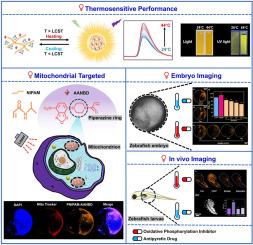荧光聚合物温度计用于斑马鱼胚胎和幼虫的实时线粒体温度成像
IF 4.2
3区 工程技术
Q2 CHEMISTRY, APPLIED
引用次数: 0
摘要
线粒体作为真核细胞中的生物能细胞器,表现出热调节波动,是评估真核细胞功能完整性和代谢状态的重要生物传感器。然而,线粒体的亚细胞区隔化和纳米尺度对时空分辨温度分析施加了实质性的技术限制,特别是在胚胎和体内微环境中。我们研制了一种荧光聚合物温度计,聚(n-异丙基丙烯酰胺)-1-[4-(7-硝基苯并[1,2,5]恶二唑-4-基)-哌嗪-1-基]-丙烯(PNIPAM-AANBD)。它设计有一个哌嗪环,能够与特定的线粒体分子建立氢键相互作用,并有一个烷基侧链,增强亲脂性。这种双重功能设计实现了线粒体的精确靶向。值得注意的是,PNIPAM-AANBD在24.0-44.0°C的生理相关温度范围内显示出明显的热响应荧光增强。鉴于探针具有卓越的时空分辨率和线粒体热特异性,我们建立了斑马鱼胚胎和幼虫系统来测试荧光聚合物温度计的可行性和有效性。在高温诱导实验中,与对照组相比,斑马鱼胚胎的平均荧光强度增加了25%,幼虫的平均荧光强度增加了49%。相反,在解热实验中,斑马鱼胚胎的平均荧光强度随着解热剂浓度的增加呈梯度下降(46% - 69%),而幼虫的平均荧光强度由于不同类型的解热剂(吉尼平和安东尼丁)的不同而下降30% - 36%。这种荧光聚合物温度计提供了一种简单有效的方法来纵向监测线粒体温度,无论是体外还是体内,以阐明与线粒体功能相关的基本生理和病理过程。本文章由计算机程序翻译,如有差异,请以英文原文为准。

Fluorescence polymer thermometer for the real-time mitochondrial temperature imaging of zebrafish embryos and larvae
As the bioenergetic organelles in eukaryotic cells, mitochondria exhibit thermoregulatory fluctuations, making them a critical biosensor for evaluating the functional integrity and metabolic states of eukaryotic cells. However, mitochondria’s subcellular compartmentalization and nanoscale dimensions impose substantial technical constraints on spatiotemporally resolved thermometric analyses, particularly in embryos and in vivo microenvironments. Here, we have developed a fluorescence polymer thermometer, poly(N-isopropylacrylamide)-1-[4-(7-nitrobenzo [1,2,5] oxadiazol-4-yl)-piperazin-1-yl]-propenone (PNIPAM-AANBD). It is designed with a piperazine ring capable of establishing hydrogen bonding interactions with particular mitochondrial molecules and an alkyl side chain that enhances lipophilicity. This dual-functional design achieves precise targeting of mitochondria. Notably, PNIPAM-AANBD displays pronounced thermoresponsive fluorescence enhancement across the physiologically relevant temperature range of 24.0–44.0 °C. Given the probe’s exceptional spatiotemporal resolution and mitochondrial thermal specificity, we established zebrafish embryo and larval systems to test the feasibility and efficacy of the fluorescence polymer thermometer. In the hyperthermia induction assay, compared to the control group, the average fluorescence intensity of zebrafish embryos increased by 25 %, and that of larvae increased by 49 %. In contrast, during the antipyretic assays, the average fluorescence intensity of zebrafish embryos decreased in a gradient manner (46 %–69 %) with the increase in concentration of antipyretic reagents, while that of larvae decreased by 30 %–36 % due to different types of antipyretic reagents (genipin and antondine). This fluorescence polymer thermometer offers a simple, effective method for longitudinal monitoring of mitochondrial temperature both in vitro and in vivo to elucidate fundamental physiological and pathological processes related to mitochondrial function.
求助全文
通过发布文献求助,成功后即可免费获取论文全文。
去求助
来源期刊

Dyes and Pigments
工程技术-材料科学:纺织
CiteScore
8.20
自引率
13.30%
发文量
933
审稿时长
33 days
期刊介绍:
Dyes and Pigments covers the scientific and technical aspects of the chemistry and physics of dyes, pigments and their intermediates. Emphasis is placed on the properties of the colouring matters themselves rather than on their applications or the system in which they may be applied.
Thus the journal accepts research and review papers on the synthesis of dyes, pigments and intermediates, their physical or chemical properties, e.g. spectroscopic, surface, solution or solid state characteristics, the physical aspects of their preparation, e.g. precipitation, nucleation and growth, crystal formation, liquid crystalline characteristics, their photochemical, ecological or biological properties and the relationship between colour and chemical constitution. However, papers are considered which deal with the more fundamental aspects of colourant application and of the interactions of colourants with substrates or media.
The journal will interest a wide variety of workers in a range of disciplines whose work involves dyes, pigments and their intermediates, and provides a platform for investigators with common interests but diverse fields of activity such as cosmetics, reprographics, dye and pigment synthesis, medical research, polymers, etc.
 求助内容:
求助内容: 应助结果提醒方式:
应助结果提醒方式:


